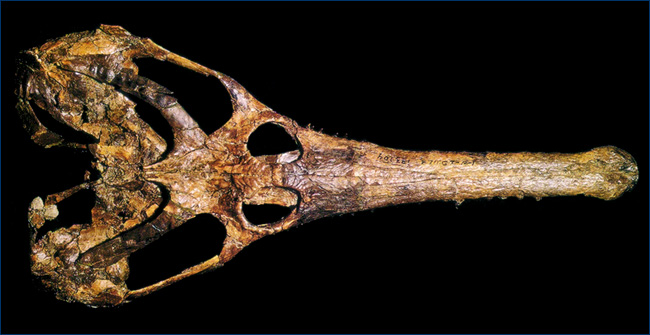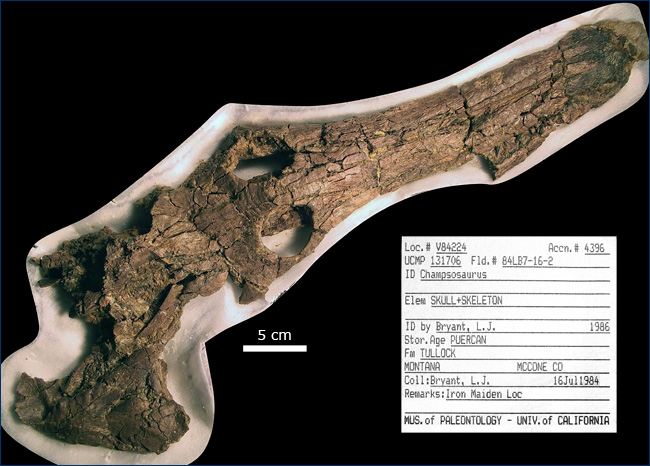
Choristodera
The champsosaurs
Choristoderes, sometimes informally called champsosaurs, are a clade of semiaquatic diapsids with an extremely long stratigraphic range. The first choristoderes were described in the late 1800s, but until the early 1990s they were only known from the Upper Cretaceous and Paleocene of North America and Europe, a span of about 15 million years. Although the relationships of choristoderes to other taxa have been (and remain) murky, they do not appear to be closely related to any groups that existed after the Triassic Period. This implied a long ghost lineage (a timespan when the animals were known to be alive, but are not represented in the fossil record) of at least 150 million years.
Starting in the 1990s, this ghost range was filled in by new discoveries and the reinterpretation of old fossils. Choristoderes are now known from the Lower Cretaceous, the Middle and Upper Jurassic, and even the Upper Triassic. In addition, more recent choristoderes have also been discovered. Choristoderes were also described from the Oligocene in 1992, and from the early Miocene in 2005. Choristoderes were around for more than 180 million years, making them one of the longest-surviving groups of vertebrates. Another way to put it: during the last 200 million years, 7/8 of the time there were choristoderes alive somewhere.
New discoveries of choristoderes in the high Arctic, China, and Japan have also expanded the known geographic range of the group. So far, no choristoderes are known from any southern continent, but this could be an artifact of preservation.
Ecology
The most familiar choristoderes, like Champsosaurus, resembled modern crocodilians, especially gavials. Gavials have long, narrow, toothy jaws that they use to catch fish, and the "gavialiform" choristoderes probably had a similar existence. Champsosaurus was also crocodile-sized, with the largest species being up to three meters long (although the largest living crocs are almost three times this length).
 Champsosaurus skull (specimen no. 133904) collected in 1987 by UCMP's Kyoko Kishi and Mark Goodwin from the Hell Creek Formation, McCone County, MT. |
However, some of the newly-discovered forms are very different in size and shape. Lazarussuchus and Cteniogenys are small and short-jawed, with skulls about two inches (5 cm) long. They may have been terrestrial insectivores. Monjurosuchus looked like a fat lizard and was about the same size as an iguana, with a total length of less than a meter. Preserved skin impressions show that it had webbed feet and large keeled scales like an alligator. In size and shape, Monjurosuchus resembled the living Chinese crocodile lizard (Shinisaurus), which is a semiaquatic hunter of fish and amphibians.
The strangest choristoderes are the long-necked Shokawa and Hyphalosaurus from Japan and China, respectively. With their tiny heads and long, snake-like necks, these unusual animals look very much like nothosaurs. Hyphalosaurus was tiny; even though its total length was half a meter, most of this was neck and tail, and its body is small enough to fit in the palm of your hand. Its babies were even smaller. Excellently preserved specimens of Hyphalosaurus from China are surrounded by oblong, leathery eggs, about the size of large marbles, and babies about six inches (15 cm) long.
Remains of unidentified choristoderes have been found on Axel Heiberg island, near the northern end of Greenland in the Canadian arctic. Choristoderes are assumed to be ectothermic ("cold-blooded") like crocodiles. Along with fossil turtles from the same island, the choristoderes show that the Arctic was warmer during the Cretaceous period than it is today — although the hardiest living turtles range into southern Canada, which is hardly balmy.
Systematics
The relationships of choristoderes to other taxa are unclear. Choristoderes have been considered basal lepidosauromorphs, basal archosauromorphs, or diapsids outside the lepidosauromorph-archosauromorph clade. All of these hypotheses suggest that choristoderes originated in the Lower Triassic or possibly the late Permian, which would extend their known fossil record by at least an additional 20 million years.
 The skull, partial right mandible, and some postcranial bones of Champsosaurus (specimen no. 131706), collected by UCMP's Laurie J. Bryant in the Paleocene Tullock Formation of McCone County, MT, 1984. |
Sources
|
||
Text by Matt Wedel, 5/2007; Champsosaurus skull (133904) photo from UCMP archives; Champsosaurus skull, partial mandible, and postcranial bones (131706) photo by Dave Smith